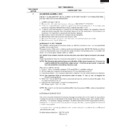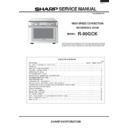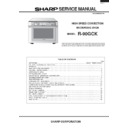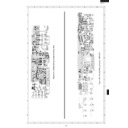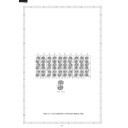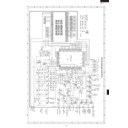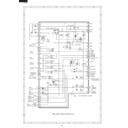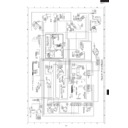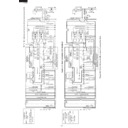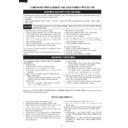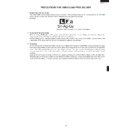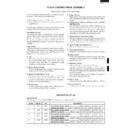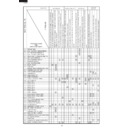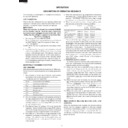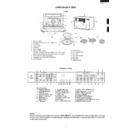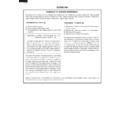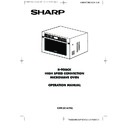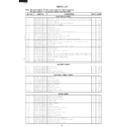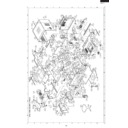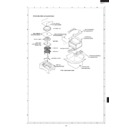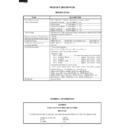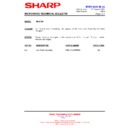Read Sharp R-90GCK (serv.man7) Service Manual online
11
R-90GCK
TEST PROCEDURES
PROCEDURE
LETTER
COMPONENT TEST
NEVER TOUCH ANY PART IN THE CIRCUIT WITH YOUR HAND OR AN INSULATED TOOL
WHILE THE OVEN IS IN OPERATION.
WHILE THE OVEN IS IN OPERATION.
1.
CARRY OUT 3D CHECKS.
2. Remove the back plate from the oven, referring to “BACK PLATE REMOVAL”.
3. To test for an open filament, isolate the magnetron from the high voltage circuit. A continuity check
3. To test for an open filament, isolate the magnetron from the high voltage circuit. A continuity check
across the magnetron filament leads should indicate less than 1 ohm.
4. To test for a shorted magnetron, connect the ohmmeter leads between the magnetron filament
leads and chassis ground. This test should indicate an infinite resistance. If there is little or no
resistance the magnetron is grounded and must be replaced.
resistance the magnetron is grounded and must be replaced.
5. Reconnect all leads removed from components during testing.
6. Reinstall the outer case (cabinet) and the back plate.
7. Reconnect the power supply cord after the outer case and back plate are installed.
8. Run the oven and check all functions.
6. Reinstall the outer case (cabinet) and the back plate.
7. Reconnect the power supply cord after the outer case and back plate are installed.
8. Run the oven and check all functions.
MICROWAVE OUTPUT POWER
The following test procedure should be carried out with the microwave oven in a fully assembled
condition (outer case fitted).
The power output of this oven is rated using the method specified by IEC 60705. Full details of how
to curry out this procedure can be found in the Sharp Technical Training notes which is available from
Sharp Parts Centre (part number SERV-LITMW01).
The following test procedure should be carried out with the microwave oven in a fully assembled
condition (outer case fitted).
The power output of this oven is rated using the method specified by IEC 60705. Full details of how
to curry out this procedure can be found in the Sharp Technical Training notes which is available from
Sharp Parts Centre (part number SERV-LITMW01).
The IEC60705 procedure must be carried out using laboratory-type procedures and equip-
ment.
These requirements make the procedure unsuitable for routine performance checks.
ment.
These requirements make the procedure unsuitable for routine performance checks.
NOTE: The following test method gives an indication of the output power only, it cannot be
used to establish the actual/rated output power. If the true output power is required,
then the IEC60705 test method must be used.
then the IEC60705 test method must be used.
Alternative simplified method:
1. Place 2 litres of cold water (between 12
1. Place 2 litres of cold water (between 12
°
C and 20
°
C) in a suitable container.
2. Stir the water and measure the temperature in
°
C. Note temperature as T1.
3. Place the container in the microwave and heat the water for 1 minute and 33 seconds on full power.
NOTE: The operation time of microwave oven includes "3" sec. (3 sec. is magnetron
filament heat-up time.)
4. When the 1 minute and 33 seconds is completed, remove the container and stir the water. Note
the water temperature as T2.
5. Calculate the output power using the following formula:
R.F. Power Output = (T2 - T1) x 90.
NOTE: The result from this test should be within the allowance of 2000cc alternative method.
(
±
10%).
MICROWAVE LEAKAGE TEST
This oven should be tested for microwave leakage on completion of any repair or adjustment,
following the procedure described in the Sharp Technical Training notes (part number SERV-
LITMW01). The maximum leakage permitted in BS EN 60335-2-25 is 50W/m
following the procedure described in the Sharp Technical Training notes (part number SERV-
LITMW01). The maximum leakage permitted in BS EN 60335-2-25 is 50W/m
2
(equivalent to 5W/m
2
),
however it is not normal to detect any significant leakage, therefore, any leakage which is detected
should be investigated.
should be investigated.
It is essential that only leakage detectors with current calibration traceable to National Physical
Laboratories are used.
Laboratories are used.
Suitable leakage detectors: CELTEC A100
APOLLO X1
A
MAGNETRON ASSEMBLY TEST
12
R-90GCK
TEST PROCEDURES
PROCEDURE
LETTER
COMPONENT TEST
WARNING: High voltage and large currents are present at the secondary winding and
filament winding of the high voltage transformer. It is very dangerous to work
near this part when the oven is on. NEVER make any voltage measurements
of the high-voltage circuits, including the magnetron filament.
near this part when the oven is on. NEVER make any voltage measurements
of the high-voltage circuits, including the magnetron filament.
1.
CARRY OUT 3D CHECKS.
2. Remove the back plate from the oven, referring to “BACK PLATE REMOVAL”.
3. Disconnect the leads to the primary winding of the high voltage transformer. Disconnect the
3. Disconnect the leads to the primary winding of the high voltage transformer. Disconnect the
filament and secondary winding connections from the rest of the HV circuitry. Using an ohmmeter,
set on a low range, it is possible to check the continuity of all three winding. The following readings
should be obtained:-
set on a low range, it is possible to check the continuity of all three winding. The following readings
should be obtained:-
a. Primary winding .......................... 1.3 ohms approximately
b. Secondary winding ...................... 95 ohms approximately
c. Filament winding ..................................... less than 1 ohm
b. Secondary winding ...................... 95 ohms approximately
c. Filament winding ..................................... less than 1 ohm
If the readings obtained are not stated as above, then the high voltage transformer is probably
faulty and should be replaced.
faulty and should be replaced.
4. Also, the high voltage transformer has the thermostat in the primary coil. Measure the resistance
of the primary coil. The resistance of the primary coil should be above resistance unless the
temperature of the thermostat in the primary coil reaches approximately 160˚C. The thermostat
resets automatically at 105˚C. If an ohmmeter indicates an open circuit under normal condition,
replace the high voltage transformer because the primary coil (thermostat) has opened. An open
primary coil (thermostat) indicates overheating of the high voltage transformer. Check for
restricted air flow to the high voltage transformer, especially the fan motor (high voltage
transformer side).
temperature of the thermostat in the primary coil reaches approximately 160˚C. The thermostat
resets automatically at 105˚C. If an ohmmeter indicates an open circuit under normal condition,
replace the high voltage transformer because the primary coil (thermostat) has opened. An open
primary coil (thermostat) indicates overheating of the high voltage transformer. Check for
restricted air flow to the high voltage transformer, especially the fan motor (high voltage
transformer side).
5. CARRY OUT 4R CHECKS.
B
HIGH VOLTAGE TRANSFORMER TEST
1. CARRY OUT 3D CHECKS.
2. Remove the back plate from the oven, referring to “BACK PLATE REMOVAL”.
3. Isolate the high voltage rectifier assembly from the HV circuit. The high voltage rectifier can be
2. Remove the back plate from the oven, referring to “BACK PLATE REMOVAL”.
3. Isolate the high voltage rectifier assembly from the HV circuit. The high voltage rectifier can be
tested using an ohmmeter set to its highest range. Connect the ohmmeter across the terminal of
the high voltage rectifier and note the reading obtained. Reverse the meter leads and note this
second reading. The normal resistance is infinite in one direction and more than 100 k
the high voltage rectifier and note the reading obtained. Reverse the meter leads and note this
second reading. The normal resistance is infinite in one direction and more than 100 k
Ω
in the other
direction.
4. CARRY OUT 4R CHECKS.
NOTE: FOR MEASUREMENT OF THE RESISTANCE OF THE RECTIFIER, THE BATTERIES OF
THE MEASURING INSTRUMENT MUST HAVE A VOLTAGE AT LEAST 6 VOLTS, BECAUSE
OTHERWISE AN INFINITE RESISTANCE MIGHT BE SHOWN IN BOTH DIRECTIONS.
OTHERWISE AN INFINITE RESISTANCE MIGHT BE SHOWN IN BOTH DIRECTIONS.
C
HIGH VOLTAGE RECTIFIER TEST
1. CARRY OUT 3D CHECKS.
2. Remove the back plate from the oven, referring to “BACK PLATE REMOVAL”.
3. Isolate the high voltage capacitor from the circuit.
4. Continuity check must be carried out with measuring instrument which is set to the highest
2. Remove the back plate from the oven, referring to “BACK PLATE REMOVAL”.
3. Isolate the high voltage capacitor from the circuit.
4. Continuity check must be carried out with measuring instrument which is set to the highest
resistance range.
5. A normal capacitor shows continuity for a short time (kick) and then a resistance of about 10M
Ω
after it has been charged.
6. A short-circuited capacitor shows continuity all the time.
7. An open capacitor constantly shows a resistance about 10 M
7. An open capacitor constantly shows a resistance about 10 M
Ω
because of its internal 10M
Ω
resistance.
8. When the internal wire is opened in the high voltage capacitor, the capacitor shows an infinite
resistance.
9. The resistance across all the terminals and the chassis must be infinite when the capacitor is
normal. If incorrect reading are obtained, the high voltage capacitor must be replaced.
10.CARRY OUT 4R CHECKS.
D
HIGH VOLTAGE CAPACITOR TEST
13
R-90GCK
TEST PROCEDURES
PROCEDURE
LETTER
COMPONENT TEST
E
SWITCH TEST
1. CARRY OUT 3D CHECKS.
2. Isolate the switch to be tested and using an ohmmeter check between the terminals as described
2. Isolate the switch to be tested and using an ohmmeter check between the terminals as described
in the following table.
If incorrect readings are obtained, make the necessary switch adjustment or replace the switch.
3. CARRY OUT 4R CHECKS.
1. CARRY OUT 3D CHECKS.
2. Remove the back plate from the oven, referring to “BACK PLATE REMOVAL”.
3. If the high voltage fuse is blown, there could be a short in the high voltage rectifier or the magnetron.
2. Remove the back plate from the oven, referring to “BACK PLATE REMOVAL”.
3. If the high voltage fuse is blown, there could be a short in the high voltage rectifier or the magnetron.
Check them and replace the defective parts and the high voltage fuse.
4. CARRY OUT 4R CHECKS.
CAUTION: ONLY REPLACE HIGH VOLTAGE FUSE WITH THE CORRECT VALUE REPLACE-
MENT.
Table: Terminal Connection of Switch
Plunger Operation
COM to NO
COM to NC
Released
Open circuit
Short circuit
Depressed
Short circuit
Open circuit
COM; Common terminal,
NO;
NO;
Normally open terminal
NC;
Normally close terminal
F
HIGH VOLTAGE FUSE TEST
1. CARRY OUT 3D CHECKS.
2. Disconnect the leads from the terminals of noise filter.
2. Disconnect the leads from the terminals of noise filter.
Using an ohmmeter, check between the terminals as described
in the following table.
in the following table.
MEASURING POINTS
INDICATION OF OHMMETER
Between N and L
Approx. 680 k
Ω
Between terminal N and WHITE
Short circuit
Between terminal L and RED
Short circuit
If incorrect readings are obtained, replace the noise filter unit.
CARRY OUT 4R CHECKS.
G
NOISE FILTER TEST
1. CARRY OUT 3D CHECKS.
2. If the fuse 20A is blown, there is a shorts or grounds in electrical parts or wire harness Check then
2. If the fuse 20A is blown, there is a shorts or grounds in electrical parts or wire harness Check then
and replace the defective parts or repaire the wire harness.
3. CARRY OUT 4R CHECKS.
H
BLOWN FUSE 20A
1. CARRY OUT 3D CHECKS.
2. If the fuse F10A is blown when the door is opened, check the secondary interlock switch, relay RY2
2. If the fuse F10A is blown when the door is opened, check the secondary interlock switch, relay RY2
and monitor switch.
3. If the fuse F10A is blown by incorrect door switching, replace the defective switch(s) and the fuse
F10A.
4. If the fuse F10A is blown, there is a shorts or grounds in electrical parts or wire harness.
Check them and replace the defective parts or repair the wire harness.
5. CARRY OUT 4R CHECKS.
CAUTION: ONLY REPLACE FUSE F10A WITH CORRECT VALUE REPLACEMENT.
I
BLOWN FUSE F10A
FUSE
20A
N
L
LINE CROSS CAPACITOR 1.0
µ
/AC275V
NOISE SUPPRESSION COIL
LINE BYPASS
CAPACITOR
0.0047
CAPACITOR
0.0047
µ
/AC250V
LINE BYPASS
CAPACITOR
0.0047
CAPACITOR
0.0047
µ
/AC250V
RESISTOR
10M 1/2W
10M 1/2W
RESISTOR 680K 1/2W
WHT
RED
NOISE FILTER
14
R-90GCK
TEST PROCEDURES
PROCEDURE
LETTER
COMPONENT TEST
J
MAGNETRON TEMPERATURE FUSE TEST
1. CARRY OUT 3D CHECKS.
2. A continuity check across the temperature fuse terminals should indicate a closed circuit unless
2. A continuity check across the temperature fuse terminals should indicate a closed circuit unless
the temperature of the magnetron reaches approximately 150˚C. An open temperature fuse
indicates overheating of the magnetron. Check for restricted air flow to the magnetron, especially
the cooling duct and cooling fan.
indicates overheating of the magnetron. Check for restricted air flow to the magnetron, especially
the cooling duct and cooling fan.
3. CARRY OUT 4R CHECKS.
CAUTION: IF THE TEMPERATURE FUSE INDICATES AN OPEN CIRCUIT AT ROOM TEMPERA-
TURE, REPLACE TEMPERATURE FUSE.
1. CARRY OUT 3D CHECKS.
2. A continuity check across the thermal cut-out terminals should indicate a closed circuit unless the
2. A continuity check across the thermal cut-out terminals should indicate a closed circuit unless the
temperature of the thermal cut-out reaches approximately 170˚C. The thermal cut-out resets
automatically at approximately 155˚C. If thermal cut-out has opened under normal condition,
replace the same item as in the parts list.
An open thermal cut-out indicates overheating of the top heating element unit. Check for restricted
air flow to the top heat element unit through the vent holes of the oven cavity, especially the heater
duct upper and convection fan.
automatically at approximately 155˚C. If thermal cut-out has opened under normal condition,
replace the same item as in the parts list.
An open thermal cut-out indicates overheating of the top heating element unit. Check for restricted
air flow to the top heat element unit through the vent holes of the oven cavity, especially the heater
duct upper and convection fan.
3. CARRY OUT 4R CHECKS.
CAUTION: IF THE THERMAL CUT-OUT INDICATES AN OPEN CIRCUIT AT ROOM TEMPERA-
TURE, REPLACE THERMAL CUT-OUT.
K
THERMAL CUT-OUT (TOP HEATER) TEST
1. CARRY OUT 3D CHECKS.
2. A continuity check across the thermal cut-out terminals should indicate a closed circuit unless the
2. A continuity check across the thermal cut-out terminals should indicate a closed circuit unless the
temperature of the thermal cut-out reaches approximately 150˚C. The thermal cut-out resets
automatically at approximately 130˚C. If thermal cut-out has opened under normal condition,
replace the same item as in the parts list.
An open thermal cut-out indicates overheating of the side heating element unit. Check for
restricted air flow to the side heat element unit through the vent holes of the oven cavity, especially
the heater duct left and convection fan.
automatically at approximately 130˚C. If thermal cut-out has opened under normal condition,
replace the same item as in the parts list.
An open thermal cut-out indicates overheating of the side heating element unit. Check for
restricted air flow to the side heat element unit through the vent holes of the oven cavity, especially
the heater duct left and convection fan.
3. CARRY OUT 4R CHECKS.
CAUTION: IF THE THERMAL CUT-OUT INDICATES AN OPEN CIRCUIT AT ROOM TEMPERA-
TURE, REPLACE THERMAL CUT-OUT.
L
THERMAL CUT-OUT (SIDE HEATER) TEST
1. CARRY OUT 3D CHECKS.
2. Make sure the heating element is fully cooled and test as follows;
2. Make sure the heating element is fully cooled and test as follows;
a. Disconnect wire leads from the heating element and measure the resistance with an ohmmeter.
On the R x 1 scale, the resistance between the heating element terminals should be approximately
37.2
37.2
Ω
.
b. Disconnect wire leads from the heating element and measure the insulation resistance with
500V - 100M
Ω
insulation resistance meter. The insulation resistance between heating element
terminal and cavity should be more than 0.5M
Ω
.
3. If the meter does not indicate above resistance, replace the top heating element.
4. CARRY OUT 4R CHECKS.
4. CARRY OUT 4R CHECKS.
M
TOP HEATING ELEMENT TEST
1. CARRY OUT 3D CHECKS.
2. Make sure the heating element is fully cooled and test as follows;
2. Make sure the heating element is fully cooled and test as follows;
a. Disconnect wire leads from the heating element and measure the resistance with an ohmmeter. On the
R x 1 scale, the resistance between the heating element terminals should be approximately 55.7
Ω
.
N
SIDE HEATING ELEMENT TEST

